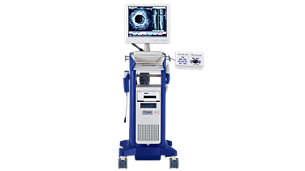Please filled in the information below and we will get in touch with you for the next step of the competition.
iFR is now recommended by the European Society of Cardiology (ESC) guidelines 8
| Recommendations | Class | Level |
| iFR/FFR to identify hemodynamically relevant coronary lesion(s) in stable patients when evidence of ischemia is not available | I | A |
| FFR-guided PCI in patients with multivessel disease. | IIa | B |
DEFINE PCI:
Unseen focal lesions cause residual ischemia
The DEFINE PCI study used iFR pullback to understand the rate and causes of residual ischemia in 500 patients undergoing contemporary PCI. Early results find that residual ischemia is common, and causes are treatable.13


Angiographically focal stenosis defined as ≤ 15 mm.13
DEFINE PCI – experts discuss the key finding
Allen Jeremias discusses: DEFINE PCI
The power of choice
Philips provides you with the opportunity to use iFR which is the only clinically validated resting index (recommended by AHA and SCAI) along with FFR. In 2017 Davies et al. and Götberg et al. validated the non-inferiority of iFR compared to FFR .

FFR = Distal Coronary Pressure (Pd) (During maximal hyperemia)

iFR = Distal Coronary Pressure (Pd) (During wave-free period)

FFR A physiology index to determine the functional significance of coronary stenosis. FFR is the ratio of the distal pressure compared to the proximal pressure during maximal blood flow (hyperemia), which can be induced by injecting products such as adenosine or papaverine.

iFR

Proven outcomes

Superior value

Be sure with iFR guidance
In-depth information for lesion specific ischemia
The Cardiovascular Center of Catania prefers to use

iFR Scout

iFR Co-Registration
Watch a case study on the LAD with diffuse disease
Davide Capodanno MD and Alessio La Manna MD, practicing interventional cardiologists at
LAD deferral is safer with iFR
Sen

“In this study, we have clearly demonstrated that it is safe to defer on the basis of iFR. If I see a patient with
Dr. Sayan Sen, Consultant Cardiologist, Hammersmith Hospital & Imperial College London, discusses details of the LAD sub-study of DEFINE-FLAIR
Study aims
iFR and FFR results
Value of
-
SyncVision
The SyncVision precision guidance system is suitable with IntraSight and Core Integrated interventional platforms and streamlines lesion assessment, simplifies vessel sizing and enables precise therapy delivery all while integrating seamlessly in daily workflows in interventional suites of choice.
IGTDSYNC -
Verrata Plus
For over 20 years Philips has led the way in physiology, putting patients first through continuous innovation. Experience our 10ᵗʰ generation physiology wire: Verrata Plus.
989604186571 -
Core
The Core precision guided therapy systems offer the choice of imaging and physiology on a single integrated platform.¹ Core helps provide clarity in your approach, confidence in your decisions, and convenience in your diagnostic and interventional workflows.
IGTDCORE -
Core Mobile
Core Mobile is designed to power the future of precision guided therapy and offers the choice of imaging and physiology on a single mobile platform.¹ Core Mobile also provides clarity in your approach and confidence in your results by offering additional information during the diagnostic phase, assisting in intervention decisions.
IGTDCOREM
References












